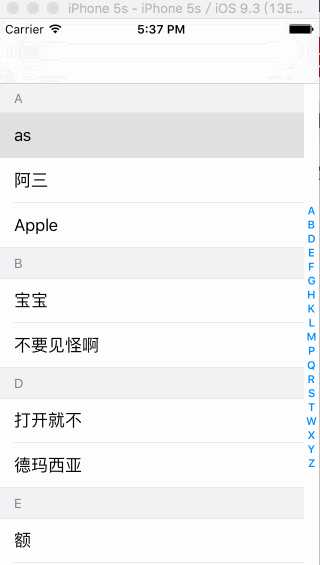(这里博主重新编辑了文章,增加了特殊字符开头的分组判定依据“#”)
闲来无事看到有人说苹果通讯录右侧字母的点击定位功能,所以就简单写了一个来给大家分享,先看下效果图:
旧图:

新图:

接着是代码部分,直接用新代码覆盖了,增加了更全的注释信息,理解起来更容易:
//
// ViewController.m
// 通讯录右侧字母点击效果
//
// Created by 刘浩浩 on 16/6/21.
// Copyright © 2016年 CodingFire. All rights reserved.
//
#import "ViewController.h"
@interface ViewController ()<UITableViewDelegate,UITableViewDataSource>
{
//非汉字和字母开头
NSMutableArray *jingChar;
//所有联系人名字头字母
NSMutableArray *charSectionArray;
//所有联系人按照头字母分组
NSMutableArray *_dataArray;
UITableView *_tableView;
}
@end
@implementation ViewController
- (void)viewDidLoad {
[super viewDidLoad];
// Do any additional setup after loading the view, typically from a nib.
_dataArray = [[NSMutableArray alloc]init];
charSectionArray = [[NSMutableArray alloc]init];
jingChar = [[NSMutableArray alloc]init];
//获取plist中的数据
NSString *plistPath = [[NSBundle mainBundle]pathForResource:@"PeopleNumber" ofType:@"plist"];
NSArray *plistArray = [NSArray arrayWithContentsOfFile:plistPath];
NSMutableArray *charArray = [[NSMutableArray alloc]init];
//获取联系人名字首字母并排序
for (int i = 0; i < plistArray.count; i++) {
NSString *plistIndex = plistArray[i];
NSString *charFirst = [self firstCharactor:plistIndex];
if ([self MatchLetter:charFirst]) {
[charArray addObject:charFirst];
}
else
{
//将不是字母和文字开头的特殊字符打头的string加入#分组
[jingChar addObject:plistArray[i]];
}
}
//去除重复的object
NSSet *set = [NSSet setWithArray:charArray];
//将NSSet转化回数组
NSArray *sortDesc = @[[[NSSortDescriptor alloc] initWithKey:nil ascending:YES]];
NSArray *sortSetArray = [set sortedArrayUsingDescriptors:sortDesc];
//按A-Z排序
NSArray *charAllArray = [sortSetArray sortedArrayUsingComparator:^NSComparisonResult(id obj1, id obj2){
return [obj1 compare:obj2 options:NSNumericSearch];
}];
//将联系人根据名字首字母进行分组
/*
*此分组方法最大的缺陷就是需要一个个比对,所以属于耗时操作,运行后并不会立马显示数据,而是需要一定时间的数据处理,如果要用的话最好在存储方法上开线程后台比对处理来存储,或者预处理,不要在进入这个界面时才处理
*/
for (int i = 0; i < charAllArray.count; i++) {
NSString *charStr = charAllArray[i];
NSMutableArray *subCharArray=[[NSMutableArray alloc]init];
for (int j=0; j < plistArray.count; j++) {
NSString *subCharStr = [self firstCharactor:plistArray[j]];
if ([charStr isEqualToString:subCharStr]) {
[subCharArray addObject:plistArray[j]];
}
}
[_dataArray addObject:subCharArray];
}
[_dataArray addObject:jingChar];
charSectionArray=[NSMutableArray arrayWithArray:charAllArray];
[charSectionArray addObject:@"#"];
[self creatTableView];
}
#pragma mark 正则表达式
-(BOOL)MatchLetter:(NSString *)str
{
//判断是否以字母开头
NSString *ZIMU = @"^[A-Za-z]+$";
NSPredicate *regextestA = [NSPredicate predicateWithFormat:@"SELF MATCHES %@", ZIMU];
if ([regextestA evaluateWithObject:str] == YES)
return YES;
else
return NO;
}
-(BOOL)isChineseFirst:(NSString *)firstStr
{
//是否以中文开头(unicode中文编码范围是0x4e00~0x9fa5)
int utfCode = 0;
void *buffer = &utfCode;
NSRange range = NSMakeRange(0, 1);
//判断是不是中文开头的,buffer->获取字符的字节数据 maxLength->buffer的最大长度 usedLength->实际写入的长度,不需要的话可以传递NULL encoding->字符编码常数,不同编码方式转换后的字节长是不一样的,这里我用了UTF16 Little-Endian,maxLength为2字节,如果使用Unicode,则需要4字节 options->编码转换的选项,有两个值,分别是NSStringEncodingConversionAllowLossy和NSStringEncodingConversionExternalRepresentation range->获取的字符串中的字符范围,这里设置的第一个字符 remainingRange->建议获取的范围,可以传递NULL
BOOL b = [firstStr getBytes:buffer maxLength:2 usedLength:NULL encoding:NSUTF16LittleEndianStringEncoding options:NSStringEncodingConversionExternalRepresentation range:range remainingRange:NULL];
if (b && (utfCode >= 0x4e00 && utfCode <= 0x9fa5))
return YES;
else
return NO;
}
#pragma mark - creatTableView
- (void)creatTableView
{
_tableView = [[UITableView alloc]initWithFrame:self.view.bounds style:UITableViewStyleGrouped];
_tableView.delegate = self;
_tableView.dataSource = self;
[self.view addSubview:_tableView];
[_tableView reloadData];
}
//获取拼音首字母(传入汉字字符串, 返回大写拼音首字母)
- (NSString *)firstCharactor:(NSString *)aString
{
//转成了可变字符串
NSMutableString *str = [NSMutableString stringWithString:aString];
//先转换为带声调的拼音
CFStringTransform((CFMutableStringRef)str,NULL, kCFStringTransformMandarinLatin,NO);
//再转换为不带声调的拼音
CFStringTransform((CFMutableStringRef)str,NULL, kCFStringTransformStripDiacritics,NO);
//转化为大写拼音
NSString *pinYin = [str capitalizedString];
//获取并返回首字母
return [pinYin substringToIndex:1];
}
#pragma mark - UITableViewDelegate
- (NSInteger)tableView:(UITableView *)tableView numberOfRowsInSection:(NSInteger)section
{
return [_dataArray[section] count];
}
- (NSInteger)numberOfSectionsInTableView:(UITableView *)tableView
{
return charSectionArray.count;
}
- (CGFloat)tableView:(UITableView *)tableView estimatedHeightForRowAtIndexPath:(NSIndexPath *)indexPath
{
return 44;
}
- (CGFloat)tableView:(UITableView *)tableView heightForFooterInSection:(NSInteger)section
{
return 0.0001;
}
- (CGFloat)tableView:(UITableView *)tableView heightForHeaderInSection:(NSInteger)section
{
return 30;
}
- (NSString *)tableView:(UITableView *)tableView titleForHeaderInSection:(NSInteger)section
{
return [NSString stringWithFormat:@"%@",charSectionArray[section]];
}
//索引
//一共有两个方法
//第一个方法用返回显示的索引是什么
-(NSArray *)sectionIndexTitlesForTableView:(UITableView *)tableView
{
return charSectionArray;
}
//第二个方法的作用当点击索引时,跳到对应分组
-(NSInteger) tableView:(UITableView *)tableView sectionForSectionIndexTitle:(NSString *)title atIndex:(NSInteger)index
{
//返回当前索引在tableView分组上的位置
return index;
}
- (UITableViewCell *)tableView:(UITableView *)tableView cellForRowAtIndexPath:(NSIndexPath *)indexPath
{
UITableViewCell *cell = [tableView dequeueReusableCellWithIdentifier:@"cell"];
if (!cell) {
cell=[[UITableViewCell alloc]initWithStyle:UITableViewCellStyleDefault reuseIdentifier:@"cell"];
}
cell.textLabel.text=[[_dataArray objectAtIndex:indexPath.section]objectAtIndex:indexPath.row];
return cell;
}
- (void)didReceiveMemoryWarning {
[super didReceiveMemoryWarning];
// Dispose of any resources that can be recreated.
}
@end
Demo下载地址:https://github.com/codeliu6572/Apple_mail_list





















